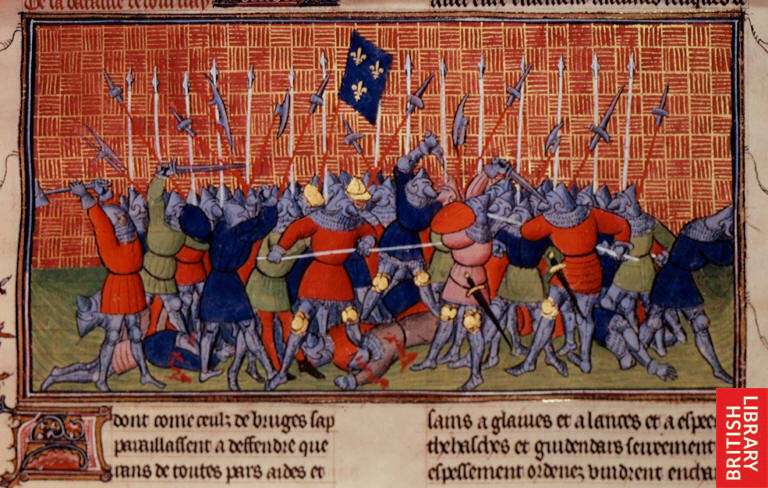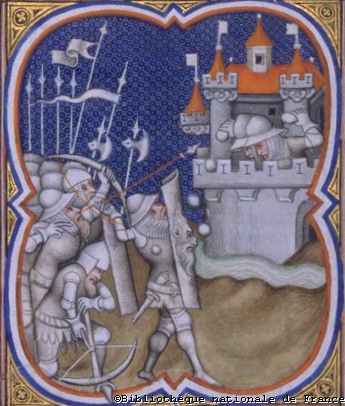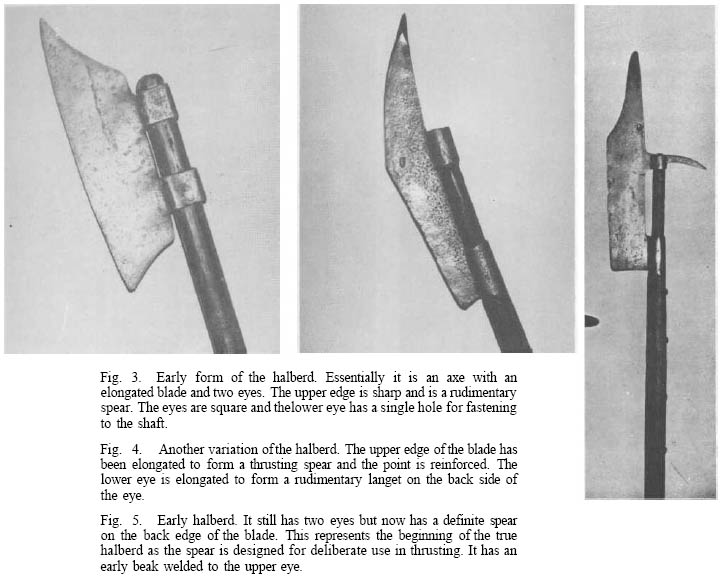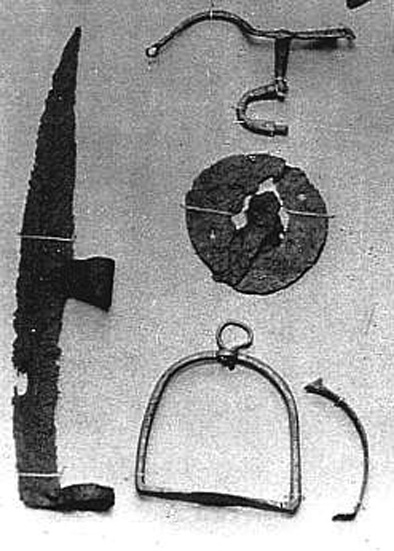| Author |
Message |
|
Aaron J. Cergol
|
 Posted: Mon 02 Jul, 2007 7:41 am Post subject: pole weapons of the 14th century Posted: Mon 02 Jul, 2007 7:41 am Post subject: pole weapons of the 14th century |
 |
|
Hi all,
I have a late (1386) northern Italian personna. I am looking into a lot of period illuminations/manuscripts/paintings, as well as reading some accounts of battle, and other various writings of the period. well reading trough various account online and in my books I see alot of references to a "battle axe".
what would this look like? also Looking at illuminations and such I see a lot of various pole weapons, so what kind of pole weapons were used? I know pole axe and spears-but what else am I missing. what about those "war hammers"?
if anyone has pictures of originals or reproduction or period manuscripts showing "battle axes", or any pole weapons of the period it is much appreciated. or any description of what they would look like-i.e. sixe, shape... I want to get a sword but It just seems like pole weapons were more "plentiful" on the field. am I right to assume this?
Thanks for your help,
Aaron J. Cergol
|
|
  |
 |
Chad Arnow
myArmoury Team


|
|
    |
 |
|
Hugh Knight
|
 Posted: Mon 02 Jul, 2007 9:55 am Post subject: Re: pole weapons of the 14th century Posted: Mon 02 Jul, 2007 9:55 am Post subject: Re: pole weapons of the 14th century |
 |
|
| Aaron J. Cergol wrote: | I have a late (1386) northern Italian personna. I am looking into a lot of period illuminations/manuscripts/paintings, as well as reading some accounts of battle, and other various writings of the period. well reading trough various account online and in my books I see alot of references to a "battle axe".
what would this look like? also Looking at illuminations and such I see a lot of various pole weapons, so what kind of pole weapons were used? I know pole axe and spears-but what else am I missing. what about those "war hammers"?
if anyone has pictures of originals or reproduction or period manuscripts showing "battle axes", or any pole weapons of the period it is much appreciated. or any description of what they would look like-i.e. sixe, shape... I want to get a sword but It just seems like pole weapons were more "plentiful" on the field. am I right to assume this? |
Any time you read "battle axe" in the late 14th or 15th centuries it's very likely you're reading about a pollaxe, *not* some peasant's pole weapon like the Halberd. The medieval French term for a pollaxe is "Hache" (as in the title of the most famous pollaxe book of all time, La Jeu de La Hache). Likewise, Fiore (an Italian fencing master from th end of the 14th/early 15th century) called the pollaxe the azza--the axe--. Likewise, Talhoffer (a German fencing master) refers to the pollaxe as "Axt" or "Streitaxt" (note that Streitaxt literally translates as "battle axe").
Note, too, that each of the fencing masters to whom I referred above uses the word pollaxe to refer to what people today often call a "pollhammer", that is, a pole weapon with a hammer head on one side and a spike on the other and a spike on top. That term also, however, is used to refer to other variations of pollaxe, e.g., those with a hammer head on one side and an axe blade on the other or an axe blade on one side and a spike on the other.
So in your sources when you read of a pollaxe or a pole hammer you're really reading about the same thing (i.e., when they say axe they might mean a weapon with a hammer head or one with an axe blade), although when I look at the iconography actually from the 14th century the pollaxe with a blade and spike seems to be the most common form.
There are no 14th-century pollaxes extant that I'm aware of, but I will try to attach some 14th-century pollaxe pictures from art here.
 Attachment: 123.32 KB Attachment: 123.32 KB

Pollaxes with hammer heads
 Attachment: 40.87 KB Attachment: 40.87 KB

Pollaxes with axe heads
Regards,
Hugh
www.schlachtschule.org
|
|
    |
 |
|
Aaron J. Cergol
|
 Posted: Mon 02 Jul, 2007 10:09 am Post subject: Posted: Mon 02 Jul, 2007 10:09 am Post subject: |
 |
|
Thanks for the help. I have seen Talhoffers and Fiores description of the weapon before. I figured that in their use/context it meant poleaxe.
but basically the termonology is somewhat varied.-kind of like coat armours of the 14th cent-i.e lentner=/jupon or gambeson=aketon/ or pourpoint=doublet... so could a lot of the termonology be dependant on where the sources came from? probably too that there was no "set name" so they called it what the will.
Aaron
|
|
  |
 |
|
Danny Grigg
|
 Posted: Fri 06 Jul, 2007 5:16 pm Post subject: Posted: Fri 06 Jul, 2007 5:16 pm Post subject: |
 |
|
The attached pics and the following text is from:
The Halberd And Other European Polearms 1300-1650 by George Snook, M.D.
"The halberd is an axe blade surmounted by a thrusting point backed by a pointed beak. This three part head is secured to a six to eight foot long shaft by a number of nails generally inserted through long straps known as langets. The langets extend along the shaft from the head towards the butt. The nails may be fastened from one side straight through the shaft to appear in a hole in the opposite langet and then peened over or alternatively they may be staggered so that they strike the opposite langet and are bent in a curved manner to lock themselves in place. The head weighs about four pounds depending on the size of the blade.
The first recorded mention of the halberd is found in a poem about the Trojan War by Konrad of Wurzburg written sometime before 1287. It mentions 6,000 men, many carrying halberds.
There are two theories regarding the halberd's initial appearance. One, suggested by 9th century murals preserved in Zurich, argues that the halberd evolved from sword blades fused to wooden shafts.The other and more plausible theory holds that the weapon developed from the fighting axe. The two handed axe favored by the Vikings is well documented. One scene in the llth century Bayeux Tapestry clearly shows a Saxon footsoldier with an axe felling a horse, displaying the power of the weapon. It appears doubtful that a hafted sword blade would be sturdy enough to perform the same deed. Furthermore the skill necessary to produce a good sword blade was rare and it would be most wasteful
to use a good sword blade in this manner. It is more logical to conclude that the halberd arises from the axe while the glaive is the descendant of the hafted sword blade.
The halberd undoubtedly developed as a means to extend the reach of the soldier, and at the same time provide him with a more useful weapon for close combat. That it succeeded will be amply demonstrated.
The early halberd is essentially a two eyed axe: a simple axe blade with two eyes rather than one. The reason for the second eye was to minimize breakage of the shaft by increasing the attachment to the wood as the single eye maximizes the stress to a single relatively narrow point. By widening the distance to two separated points the stress is spread over a wider area and the junction is potentially stronger.
The earliest halberd that can be positively identified and dated is one in the Berne Historical Museum recovered from the battlefield of Morgarten which took place in 1315. It has a nearly rectangular blade with two eyes and the upper end extended to a point for thrusting. One with a more crescent shaped blade and a rudimentary beak is found in the same museum. The blade shown above (Fig. 3) is consistent with the Morgarten type and the fact that the upper point is not prominent would suggest that this is perhaps an early design.
An early illustration of this type is found in the Votive Tablet of St. Lambrecht (c.1430) in the Landeszeughaus Graz. A woodcut discovered by John Waldman, my colleague and fellow collector, published by Johann Stumpf in the mid 16th century but depicting an event of the 14th century, illustrates a similar example with a wooden shaft extending beyond the blade and sharpened to a point. Wagner shows several of these types in his illustrations taken from sources as early as 1315 which would make this blade contemporary with the Morgarten blade.
At that time the rear facing beak was added. This will be found attached to the upper eye or sometimes as a separate detached part of the head with its own eye between the two eyes of the axe blade. It was soon simplified by combining the eyes into a socket and forging the beak to the back of the socket. This gives the halberd the basic form which persisted throughout its existence.
The changes in design of the halberd from this time onwards is very fluid. While it would be desirable to precisely date them, it cannot be done. Instead changes in the appearance of different parts of the weapon will be noted, and later these will be combined to make some stylistic order of its development."
I posted a weblink to a PDF version of this booklet a year or more ago, if you do a search you might be able to find the link, unfortunately I no longer know what the web address is.
Does anyone have a picture of the "Votive Tablet of St. Lambrecht (c.1430) in the Landeszeughaus Graz" or illustrations by "Wagner" as mentioned in the text above showing these early halberds?
Does anyone have any pics of the Morgarten Halberd (the original in the Berne Historical Museum, or modern replicas etc)?
Thanks
Danny
 Attachment: 95.81 KB Attachment: 95.81 KB

 Attachment: 36.68 KB Attachment: 36.68 KB

|
|
  |
 |
Alessandro Fantucci

|
 Posted: Fri 20 Jun, 2008 12:53 pm Post subject: Posted: Fri 20 Jun, 2008 12:53 pm Post subject: |
 |
|
HI,
I'm new in this forum  , Forgive my bad english , Forgive my bad english 
II'm an Italian Reenactor of XIV cent. (1350-1370). I've a WarHammer

i've made a copy from a private original in a book (I don't remember the title).
also waiting for an "Azza" , like hammer but with an hook:
head like this--> http://www.myArmoury.com/albums/photo/2036.html
This type of Weapon is mentioned in Flos Duellatorum (1410 Text) with techniques.
Also mentioned in Filippo Vadi and Thallofer.
I like this weapon!!!

La Rosa dei Venti
www.rd20.it
scherma@rd20.it
|
|
    |
 |
James Barker

Location: Ashburn VA Joined: 20 Apr 2005
Posts: 365
|
 Posted: Fri 20 Jun, 2008 1:49 pm Post subject: Posted: Fri 20 Jun, 2008 1:49 pm Post subject: |
 |
|
| Aaron J. Cergol wrote: | | but basically the termonology is somewhat varied.-kind of like coat armours of the 14th cent-i.e lentner=/jupon or gambeson=aketon/ or pourpoint=doublet... |
Aaron
Quick correction; aketon, pourpoint, and doublet doublet are under armor garments while lentner, jupon, and gambeson are coat armors.
James Barker
Historic Life http://www.historiclife.com/index.html
Archer in La Belle Compagnie http://www.labelle.org/
|
|
   |
 |
|
Kelly Powell
Location: lawrence, kansas Joined: 27 Feb 2008
Posts: 123
|
 Posted: Mon 23 Jun, 2008 10:52 pm Post subject: Posted: Mon 23 Jun, 2008 10:52 pm Post subject: |
 |
|
Danny Grig Do: the photos of the "early halberds" have a a touch of english bill to them or not? I'm in love with the middle one and have a scurrying of making room on the back burners for that one!
I cannot see the glaive being a sword originated pollarm....A definate yes for the naginata as a sword originated pole weapon.....I'd guess the glaive would be a hedge cutter or some such blade.....Have you ever seen pics of midaevil meat cleavers? Much differant then modern.....Of course i could just be talking out the wahzoo too!
|
|
  |
 |
|
Timm Radt
Location: Germany Joined: 12 Sep 2011
Posts: 21
|
 Posted: Sat 20 Jan, 2018 12:48 am Post subject: Posted: Sat 20 Jan, 2018 12:48 am Post subject: |
 |
|
Reopening an old thread - I just made a rediscovery in my image archive: A photo of the oldest halberd-like pole weapon I know. It was excavated in the 30ies in the ruins of a castle in the northern Black Forest, Germany. All finds stem from the first half of the 13th century. It seems that the excavators did not know what they have found as they called the object a scythe.
Does anybody know any comparable weapons from that time?
Cheers, Timm
 Attachment: 100.24 KB Attachment: 100.24 KB

|
|
  |
 |
|
|
You cannot post new topics in this forum
You cannot reply to topics in this forum
You cannot edit your posts in this forum
You cannot delete your posts in this forum
You cannot vote in polls in this forum
You cannot attach files in this forum
You can download files in this forum
|
All contents © Copyright 2003-2025 myArmoury.com — All rights reserved
Discussion forums powered by phpBB © The phpBB Group
Switch to the Basic Low-bandwidth Version of the forum
|

